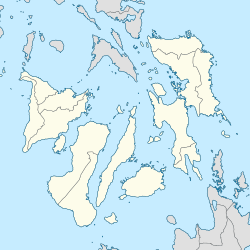
Baroque architecture is a highly decorative and theatrical style which appeared in Italy in the early 17th century and gradually spread across Europe. It was originally introduced by the Catholic Church, particularly by the Jesuits, as a means to combat the Reformation and the Protestant church with a new architecture that inspired surprise and awe. It reached its peak in the High Baroque (1625–1675), when it was used in churches and palaces in Italy, Spain, Portugal, France, Bavaria and Austria. In the Late Baroque period (1675–1750), it reached as far as Russia, the Ottoman Empire and the Spanish and Portuguese colonies in Latin America. In about 1730, an even more elaborately decorative variant called Rococo appeared and flourished in Central Europe.
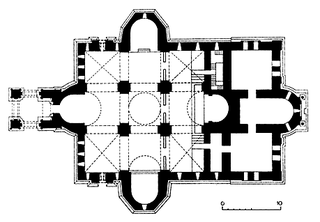
Church architecture refers to the architecture of Christian buildings, such as churches, chapels, convents, seminaries, etc. It has evolved over the two thousand years of the Christian religion, partly by innovation and partly by borrowing other architectural styles as well as responding to changing beliefs, practices and local traditions. From the Early Christianity to the present, the most significant objects of transformation for Christian architecture and design were the great churches of Byzantium, the Romanesque abbey churches, Gothic cathedrals and Renaissance basilicas with its emphasis on harmony. These large, often ornate and architecturally prestigious buildings were dominant features of the towns and countryside in which they stood. However, far more numerous were the parish churches in Christendom, the focus of Christian devotion in every town and village. While a few are counted as sublime works of architecture to equal the great cathedrals and churches, the majority developed along simpler lines, showing great regional diversity and often demonstrating local vernacular technology and decoration.

The Minor Basilica of San Sebastian, better known as San Sebastian Church or San Sebastian Basilica, is a minor basilica of the Roman Catholic Church in Manila, Philippines.

The Dominican Church, also known as the Church of St. Maria Rotunda, is an early Baroque parish church and minor basilica in the historic center of Vienna, Austria. It is the third church built on the same site in the course of time.
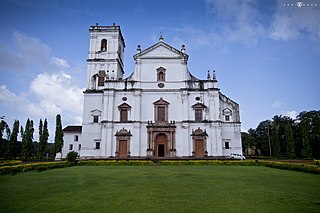
The Sé Catedral de Santa Catarina, known as Se Cathedral, is the cathedral of the Latin Church Archdiocese of Goa and Daman and the seat of the Patriarch of the East Indies. It is part of the World Heritage Site, Churches and convents of Goa located in Old Goa, India.

The Polish cathedral architectural style is a North American genre of Catholic church architecture found throughout the Great Lakes and Middle Atlantic regions as well as in parts of New England. These monumentally grand churches are not necessarily cathedrals, defined as seats of bishops or of their dioceses.

Carcar, officially the City of Carcar, is a 5th class component city in the province of Cebu, Philippines. According to the 2020 census, it has a population of 136,453 people.
The Cathedral Museum of Cebu is a museum in Downtown Cebu City in the Philippines, reopened in November 2006. It is the ecclesiastical museum of the Roman Catholic Archdiocese of Cebu.

St. John the Baptist Catholic Church is a historic Roman Catholic church in Marion Township, Mercer County, Ohio, United States. Located in the unincorporated community of Maria Stein, it is the home of an active congregation and has been recognized as a historic site because of its well-preserved late nineteenth-century Romanesque Revival architecture.

St. Remy's Catholic Church is a historic Roman Catholic church in Russia, Ohio, United States. Built in 1890, it continues to house an active parish, and it has been recognized as a historic site because of its architecture.
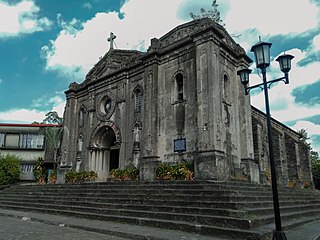
The Nuestra Señora de Gracia Church, commonly known as Guadalupe Church, is a Baroque Roman Catholic church in Makati City, Philippines. The parish church and its adjacent monastery are currently administered by the Archdiocese of Manila. The territory of the parish covers San Carlos Seminary, the major seminary of the Archdiocese of Manila and Our Lady of Guadalupe Minor Seminary. The church also has an adjacent seminary, the Monasterio de Guadalupe, which admits young professionals for priestly and religious vocation. The current parish priest is Rev. Fr. Joselito R. Martin.

The Basílica Minore del Santo Niño de Cebú, alternatively known as the Minor Basilica of the Holy Child or simply Santo Niño Basilica, is a minor basilica in Cebu City in the Philippines that was founded in 1565 by Fray Andrés de Urdaneta and Fray Diego de Herrera. It is the oldest Roman Catholic church in the country, allegedly built on the spot where the image of the Santo Niño de Cebú was found during the expedition of Miguel López de Legazpi.

Saint Augustine Parish Church, commonly known as Paoay Church, is a Roman Catholic church in the municipality of Paoay, Ilocos Norte in the Philippines. It is under the jurisdiction of the Diocese of Laoag. Completed in 1710, the church is famous for its distinctive architecture, a highlight of which is the enormous buttresses on the sides and back of the building. It is declared as a National Cultural Treasure by the Philippine government in 1973 and a UNESCO World Heritage Site under the collective group of Baroque Churches of the Philippines in 1993.

The Santa Monica Parish Church, commonly known as the Minalin Church, is a Baroque Roman Catholic church, located in poblacion area of San Nicolas in Minalin, Pampanga, Philippines. The church, built during the Spanish era, was declared a National Cultural Treasure by the National Commission for Culture and the Arts and the National Museum of the Philippines on August 27, 2011, one of 37 churches in the country bestowed that honor.
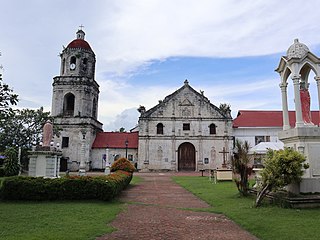
The Archdiocesan Shrine of San Miguel Arcangel, commonly known as Argao Church, is a Roman Catholic church in Argao, Cebu, Philippines. It is under the jurisdiction of the Archdiocese of Cebu. The municipality of Argao was established as a parish in 1703 under the Augustinian order. To serve the parochial needs of its people, a stone church was constructed in 1734 and was completed in 1788. The church was dedicated to Saint Michael the Archangel.

Saint Catherine of Alexandria Parish Church, commonly known as Porac Church, is a 19th-century Baroque Roman Catholic church located at Barangay Poblacion, Porac, Pampanga, Philippines. The parish church is currently under the ecclesiastical province of the Archdiocese of San Fernando.

The Archdiocesan Shrine of Patrocinio de Maria Santisima, commonly known as Boljoon Church, is a Roman Catholic church dedicated to Our Lady of the Patronage in the municipality of Boljoon, Cebu, Philippines, under the Archdiocese of Cebu.

The St. Catherine's Cathedral is the Roman Catholic cathedral of the Apostolic Vicariate of Alexandria of Egypt. It also serves as the church of the Franciscan monastery in Alexandria.

Saints Peter and Paul Cathedral, also known as the Parish of Our Lady's Nativity and commonly known as Calbayog Cathedral, is a Roman Catholic cathedral located in the city of Calbayog, Samar province, Philippines. It is the seat of the Diocese of Calbayog, a suffragan of the Palo Archdiocese. Being the first cathedral designated in Eastern Visayas in 1913, it is considered as the mother church of the region.

Our Lady of the Pillar Parish Church, also known as the Virgin of the Pillar Parish Church or simply Sibonga Church, is a Roman Catholic church in Sibonga, Cebu, Philippines. It is under the jurisdiction of the Archdiocese of Cebu.



